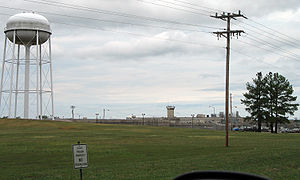
Potosi Correctional Center
Encyclopedia

Unincorporated area
In law, an unincorporated area is a region of land that is not a part of any municipality.To "incorporate" in this context means to form a municipal corporation, a city, town, or village with its own government. An unincorporated community is usually not subject to or taxed by a municipal government...
Washington County
Washington County, Missouri
Washington County is a county located in East Central Missouri in the United States. As of the 2010 U.S. Census, the county's population was 25,195. The largest city and county seat is Potosi...
, Missouri
Missouri
Missouri is a US state located in the Midwestern United States, bordered by Iowa, Illinois, Kentucky, Tennessee, Arkansas, Oklahoma, Kansas and Nebraska. With a 2010 population of 5,988,927, Missouri is the 18th most populous state in the nation and the fifth most populous in the Midwest. It...
, near Potosi
Potosi, Missouri
Potosi is a city in Washington County, Missouri, United States. Potosi is about 10 miles north of Belgrade. The estimated population in July 2008 was 2,698. It was 2,662 at the 2000 census. It is the county seat of Washington County...
. The facility currently houses 800 capital punishment, maximum security
Supermax
Supermax is the name used to describe "control-unit" prisons, or units within prisons, which represent the most secure levels of custody in the prison systems of certain countries...
and high-risk male inmates.
The facility, which opened in 1989, is a maximum security prison. As of 1989 it had about 200 prisoners.
Shortly after the prison's opening, the majority of the non-death row prisoners at Potosi were serving long sentences, such as life imprisonment
Life imprisonment
Life imprisonment is a sentence of imprisonment for a serious crime under which the convicted person is to remain in jail for the rest of his or her life...
without parole, or sentences with a fifty year minimum before parole eligibility. A small number had shorter sentences.
Death row
In April 1989 the state transferred its 70 death rowDeath row
Death row signifies the place, often a section of a prison, that houses individuals awaiting execution. The term is also used figuratively to describe the state of awaiting execution , even in places where no special facility or separate unit for condemned inmates exists.After individuals are found...
inmates from Jefferson City Correctional Center
Missouri State Penitentiary
The Missouri State Penitentiary, also known as "The Walls", was a prison in Jefferson City, Missouri that operated from 1836-2004. It was a prison of the Missouri Department of Corrections. Before its closure it was named the Jefferson City Correctional Center . Before its closure it was the oldest...
(JCCC, originally Missouri State Penitentiary) to Potosi. U. S. District Court for the Western District of Missouri approved some modifications to the consent decree before the inmates were moved to Potosi. Originally death row prisoners lived in a 92-bed, two wing facility at PCC. The death row inmates had their own special custody levels: minimum custody, medium custody, close custody, and administrative segregation
Solitary confinement
Solitary confinement is a special form of imprisonment in which a prisoner is isolated from any human contact, though often with the exception of members of prison staff. It is sometimes employed as a form of punishment beyond incarceration for a prisoner, and has been cited as an additional...
. One wing housed the minimum custody death row inmates, with another wing housing the others. The classification system was intended to award privileges to death row prisoners exhibiting good behavior. After inmates filed legal challenges, administrators began to consider whether to integrate death row prisoners into the non-death row population, because the majority of non-death row the prisoners at PCC had very long sentences and had committed similar crimes to those committed by death row inmates.
MDOC began to stop using the word "death row," believing it to be negative, and began referring to death row prisoners as ""capital punishment" (CP) inmates." For the first time in MDOC history, the state began to allow death row prisoners to leave their housing units, with staff escorts, to eat meals. When no serious incidents occurred, MDOC officials began to use an escort system so death row prisoners could use the gymnasium. The death row prisoners also began to have access to the law library, and death row prisoners were permitted to work in the laundry facility. On January 8, 1991 death row prisoners were fully mainstreamed into the population.
Executions
The Potosi Center conducted all but one of the 62 Missouri executions between 1989 when capital punishment was reinstated and 2005 when the execution chamber was moved 25 miles (40.2 km) east to the Eastern Reception, Diagnostic and Correctional CenterEastern Reception, Diagnostic and Correctional Center
The Eastern Reception, Diagnostic and Correctional Center is a 2,684-bed prison located northeast of Bonne Terre, Missouri.The ERDCC serves as the point of admission for male offenders committed by the courts in eastern Missouri to the Missouri Department of Corrections...
in Bonne Terre, Missouri
Bonne Terre, Missouri
Bonne Terre is a city in St. Francois County, Missouri, United States. The population was estimated in 2008 as 6,854. It was 4,039 at the 2000 census. The community was originally settled by the French in 1720 after lead ore was discovered...
. Death Row prisoners are housed at Potosi until being moved to Bonne Terre shortly before their scheduled execution.

